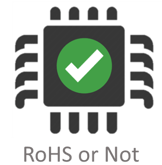Compliance basics
Welcome to the Compliance Basics section of RoHS or Not. Here, you’ll find straightforward explanations to help you understand key concepts in product compliance — whether you're designing a new device, importing electronic equipment, or launching a tech product in international markets.We’ve created this section for professionals who are new to CE marking, RoHS, FCC rules, and similar regulations. You don’t need to be a nexpert — we break it down in practical terms.
What is CE Marking?
CE marking is a symbol that shows a product meets the safety, health, and environmental protection requirements of the European Union.
It’s not a quality mark — it’s a legal requirement for many products sold in the EU, including most electrical and electronic equipment.
By placing the CE mark on your product, you’re declaring that it complies with all relevant EU directives. This is known as a self-declaration, though in some cases, third-party certification may be required.
What is RoHS?
RoHS stands for Restriction of Hazardous Substances. It’s a European directive that limits the use of toxic materials like lead, mercury, cadmium, and flame retardants in electrical and electronic equipment.
RoHS helps reduce the environmental impact and health risks associated with electronic waste.
What is FCC Compliance?
In the United States, the Federal Communications Commission (FCC) regulates electronic devices that emit radiofrequency (RF) energy — whether intentionally, like Wi-Fi and Bluetooth, or unintentionally, like microcontrollers.
If you’re selling a product in the U.S. that communicates wirelessly or includes a processor, you may need to comply with FCC Part 15 rules. That usually means testing for radiated and conducted emissions and including proper labeling.
What is a Declaration of Conformity?
The Declaration of Conformity (DoC) is a document that formally states your product complies with applicable regulations. It includes:
Your company name and address
Product details
Directives and standards applied
Signature of the responsible person
It’s required for CE marking and must be available to authorities if requested.
What is a Technical File?
A technical file (also called a technical documentation) contains the evidence that proves your product meets regulatory requirements. It’s not usually submitted in advance, but you must keep it on file in case authorities ask for it.
It often includes:
Risk assessments
Test reports
Schematics
Bill of materials (BOM)
User manuals
Declaration of Conformity
When Is Testing Required?
Some compliance rules require testing to verify safety, electromagnetic compatibility (EMC), or the presence of restricted substances.
Examples include:
EMC testing to ensure your device doesn’t interfere with others
Safety testing under EN or IEC standards
Chemical testing for RoHS substances
We can help guide you through what’s needed based on your product and market.
What’s Next?
This is just the beginning. In future updates, we’ll add detailed guides, templates, and case studies for each of these topics.
Compliance made simple
From CE to FCC – Global Certification Support


